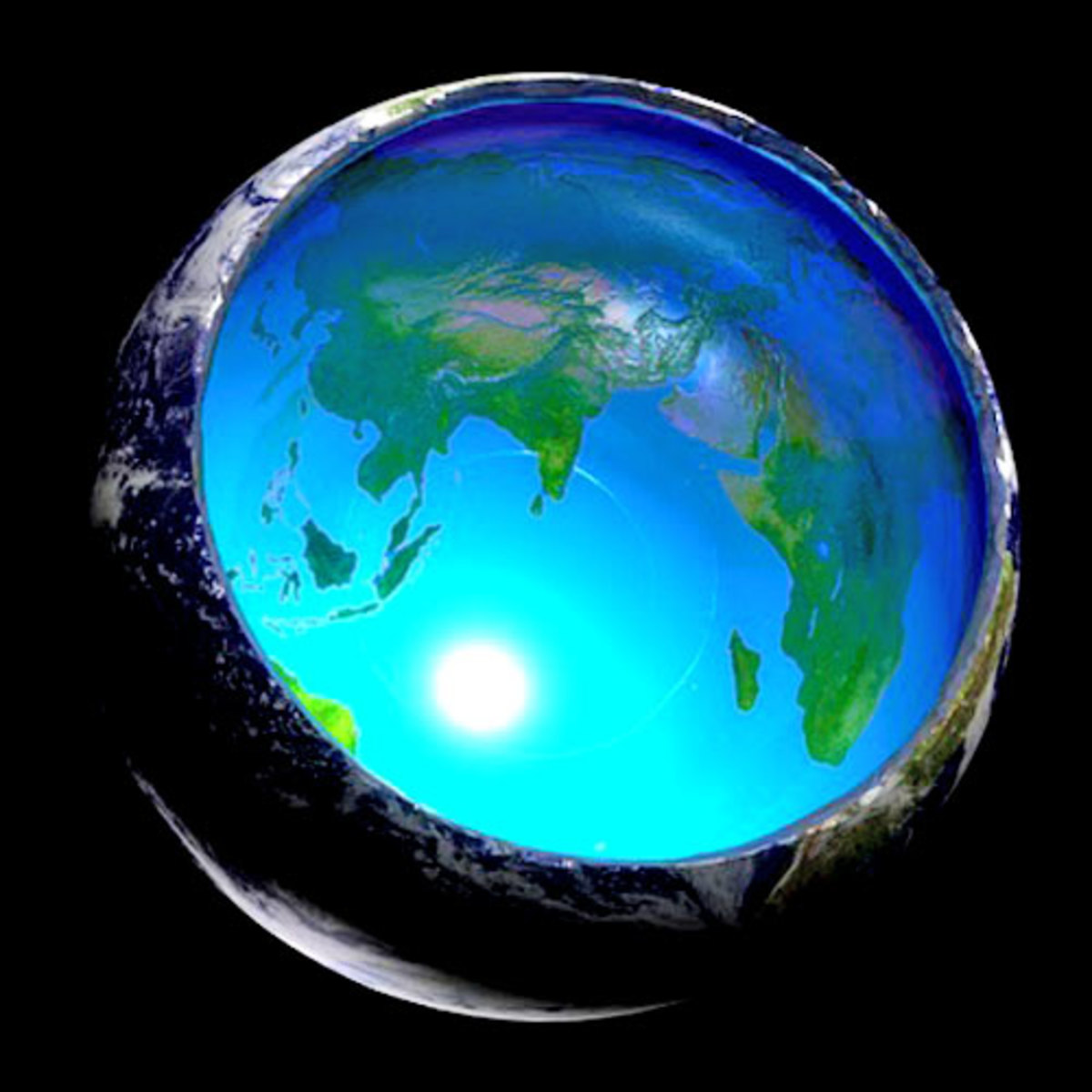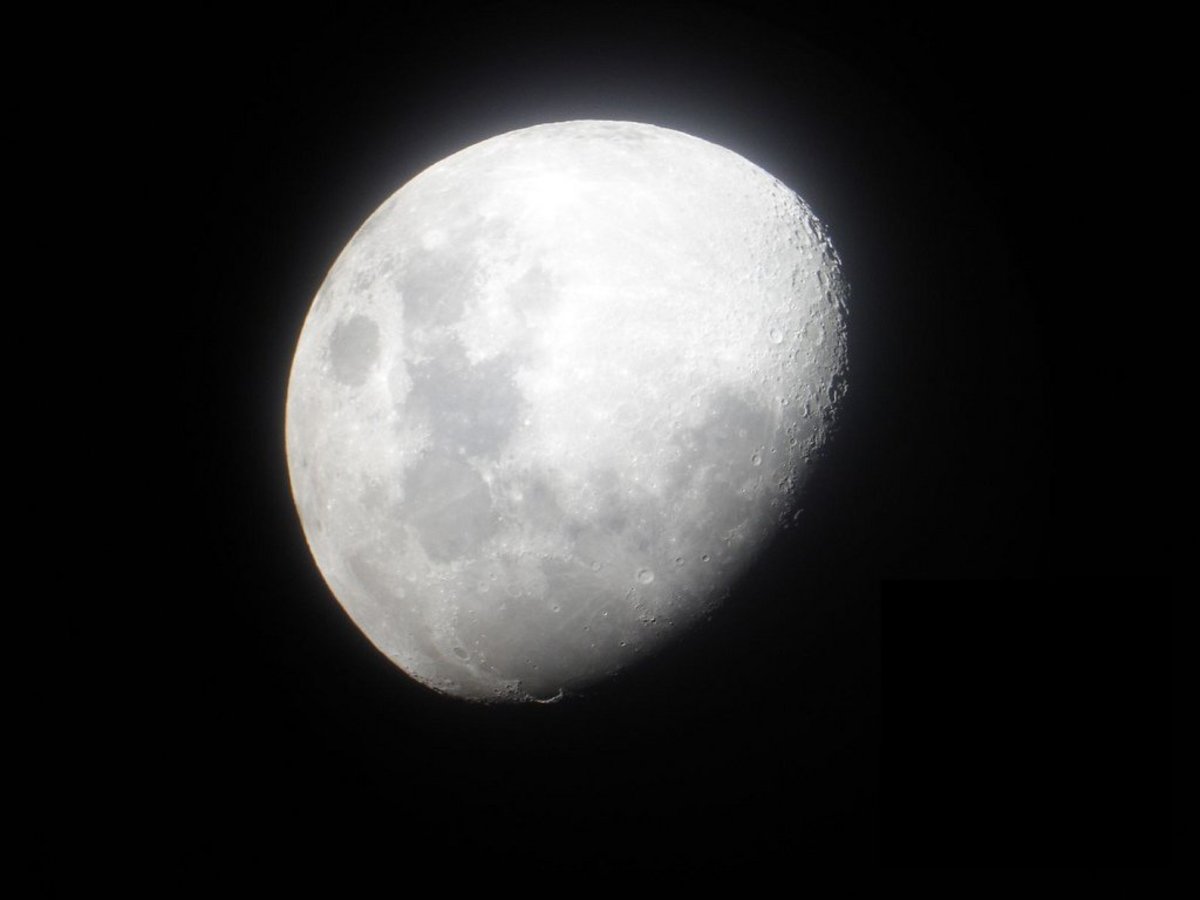The Universe...In A Nutshell
Spiral Galaxy
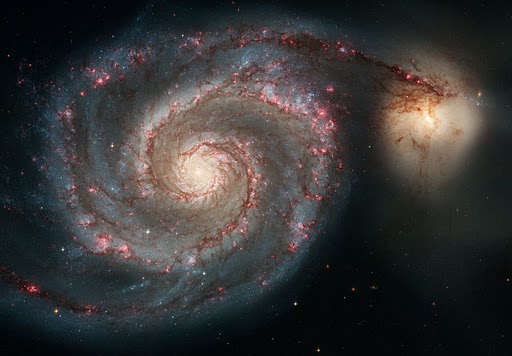
Introduction
(Please refer to the glossary at the end of the article for help with bold, italicized terms.)
It’s all subject to conjecture…but we still live here.—Bill Sego 2013
What is the main difference between cosmology and astronomy? Cosmology studies the entire Universe as a whole and astronomy individual things within it.
By definition, astronomy is the study of the physical Universe beyond Earth. It began as a working science among the Greeks during the seventh century BCE (Before Common Era), and most consider it the first, true field of science.
Cosmology is, “The science, theory, or study of the Universe as an orderly system and of the laws that govern it; in particular, a branch of astronomy that deals with the structure and evolution of the Universe.”[i]
Just over 400 years ago, Italian philosopher and astronomer Giordano Bruno suggested the Universe had an infinite number of stars orbited by an infinite number of worlds. The Roman Catholic Church branded him a heretic for those insights and burned him at the stake. Though he was closer to the truth than anyone else of that time, today, astronomers know that number, though quite large, is finite.
[i] Encyclopedia of Cosmology, 1993. “Cosmology,” p. 116.
The Solar System
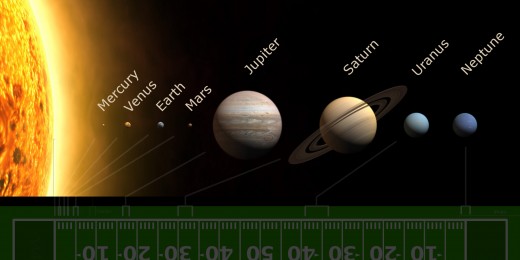
The Macrocosm
Earth is part of a solar system; the Sun, nine planets, an asteroid belt, and a handful of comets; located within the Milky Way Galaxy. A solar system is nothing more than a star and the planets and asteroids that orbit it. A galaxy is a group of gas, dust, and billions of stars grouped together by gravitational attraction, all emanating from its central core.
Extrasolar planetary evidence suggests almost every star within a particular galaxy harbors some type of solar system. There are about 400 billion stars, each harboring its own system, residing within the Milky Way. The Universe contains a conservative estimate of 200 billion galaxies throughout its vast expanse.
One light-year equals six trillion miles, which is the distance light travels in a single year. The visible Universe is 28 billion light years in diameter, and its age is estimated at 13.8 billion years.
The Milky Way is 10 times larger than the average galaxy with a diameter of 120,000 light years across. Our Sun is located 26,000 light years from its center, comfortably resting in the Goldilocks zone of the Galaxy. Light takes 70,000 years for it to travel across its entire span.
The nearest star to the Sun is Proxima Centauri. If each were analogous to the size of a basketball, they would sit four thousand miles apart in relative terms. Because of these vast distances, scientists can only dream of traveling to another star system.
The Sun takes about 30 Earth-days to make a full rotation on its axis. It takes 200 million years for the Solar System to make a complete orbit around the Milky Way. In its entire life, it has made this trek only 20 times. The Universe, itself, does not spin or rotate in the vacuum of space, but expands ever outward.
Galaxies appear as groups, or clusters. The Milky Way is part of a group of 30 galaxies, altogether known as the Local Group. Its location is near the outer part of this group where its nearest neighbor, Andromeda, is more toward the center. Andromeda is 2.5 million light years from the Milky Way. Other larger groups of galaxies, such as the Virgo Cluster, are closer to 50 million light years away. These clusters are composed of around 2,500 galaxies.
In 1995, astronomer Mark Dickinson of the Hubble Deep Field (HDF) project, with help from other scientists around the world, managed to zero in on a tiny patch of sky just above the Big Dipper. That point in the sky is no larger than a grain of sand held at arm’s reach, but the number of galaxies photographed in this frame-by-frame image is about 1,500. In 2004, the project took this image to the next level and managed to capture 10,000 galaxies over a smaller portion of the sky. The latest image, taken in September 2012 and called the eXtreme Deep Field (XDF), captured an astonishing 15,500 galaxies in an even smaller region of the sky! The image goes back 13.2 billion years, nearly to the beginning of the Universe. That number, multiplied across the sky, is around 200 billion, and there may be twice as many we have yet to discover.
Some scientists believe faraway galaxies might be distant, past reflections of familiar ones, to include the Milky Way. If one considers the distortion effect of gravity on light waves, there is a considerable possibility for that argument. Local observers could view the Milky Way as it appeared billions of years ago. The total amount of visible matter from the big bang may not be as prevalent as what is observed. The collective Universe, from a terrestrial perspective, might be similar to a hall of mirrors in a fun house.
Figure 1
Relative Star Sizes
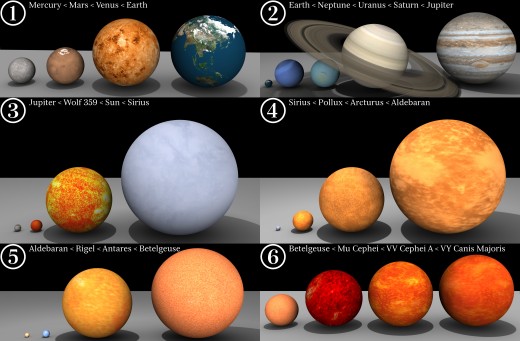
Stars
(*Please click on matching diagram link above for a visual.)
Every star in the Universe is characterized according to its spectra, or color: O, B, A, F, G, K, M, R, N, and S class. The Astronomy-101 mnemonic is “Oh, be a fine girl, kiss me right now, sweetheart!” O and B stars are massive, bright blue objects with short life spans and surface temperatures between a roasting 20,000 and 45,000 degrees Fahrenheit. A-class stars are white and two to four times the mass of the Sun. They emit a surface temperature between 13,500 and 20,000 degrees. F and G-class stars are yellow and half to twice the mass of the Sun. Surface temperatures range from 9,000 to 13,500 degrees. The Sun is an example of a yellow, G-class star. The spectra of K-class stars are orange with half to just under one solar mass. M-class stars are red and less than half the mass of the Sun. R, N, and S stars are small, dim, red orbs with lengthy life spans. Of all the different star types, A, F, G, K, and M stars are possible candidates for harboring life-supporting systems.
Pulsar and Neutron Star
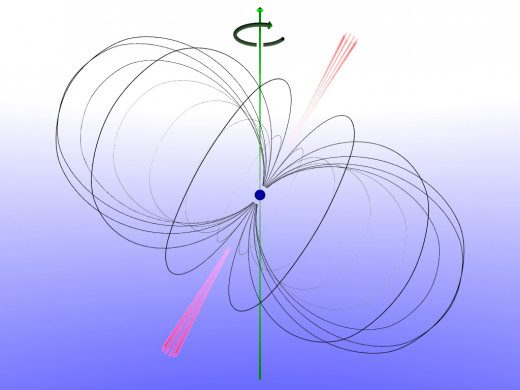
Strange Entities
Many other entities exist throughout the Universe besides stars and galaxies, some of which display quite peculiar characteristics. White dwarfs, neutron stars, pulsars, and black holes are eventual fates for stars beginning to exhaust their fuel supplies. Their attributes are quite astonishing, some downright hard to comprehend.
A white dwarf is a type of star the Sun will become in another five or six billion years. First, it will swell to become a red giant, about 120 times its original size, and then gradually shrink until it is about the size of Earth. Its solar mass, however, remains at one. This means its density will be hundreds of tons per cubic inch.
Neutron stars form of massive stars that were four or more times the size of the Sun. If the star explodes and its leftover mass is less than 3.2 times that of the Sun, it will become one of these. It will have a radius of only 10 miles and density an astonishing hundreds of millions of tons per cubic inch!
A pulsar is nothing more than a magnetized, spinning neutron star that emits regular pulses of radio waves. Some argue they are perfect universal timekeepers, keeping time within one microsecond per year. Pulsars produce over 1,000 pulses per second, or spin at a rate just under half the speed of light.
American scientist John Wheeler coined the term black hole in 1969. Black holes appear black because no light can escape them, otherwise would appear as any other star.[i] Light waves emanating from one are unable to escape its event horizon since the gravity it produces is far too strong. Light forms an endless corpuscle around its immediate vicinity, forever teetering on the edge.
Singularities are infinite points in mathematical equations. The singularity of a black hole is a point of infinite density that draws in then obliterates anything in its vicinity. Matter, light, and gravity are no exception to the consequence of its overwhelming power. Spaghettification is the term physicists use to describe the stretching that would occur to an object as it approaches a black hole. One could imagine what a person would resemble as it gets sucked into one: at first, a long, thick strand of spaghetti. Within a singularity, all three-dimensional physics break down.
Throughout the 1920s and 1930s, Einstein did not accept the notion of a black hole. It was too bizarre to fit into his commonsense notions of how the Universe ought to behave. He submitted a detailed paper in defense of this position. A revision in theory maintained his humility as an imperfect being, which proves even the most prestigious of scientists can promote incorrect ideas.
The gravitational field at the singularity of a black hole is so strong it appears to stop the flow of time. The wave crests of light seem infinitely long here, disallowing time as a measurable circumstance. Is this perspective an actual effect on the arrow or flow of time as we measure it or nothing more than a holographic projection to those outside a black hole looking in?
For Earth to form a black hole, it would have to be compressed from its present size to one inch in diameter and for the Sun, from one million miles in diameter to four miles. The Sun is much denser than Earth.
Supermassive black holes lurk at the centers of galaxies with masses at millions, perhaps billions of suns. Galactic black holes grow larger as stars fall into them. It is possible there are more black holes than number of visible stars in the entire Universe. Some aspects of reality are a lot stranger than the strangest of fiction, and only a fraction of it is visible from Earth’s menial perspective.
Rotating black holes might form other strange entities, called wormholes. Wormholes are theoretical tunnels connecting different regions of space and time or one universe to another. Like black holes, time has no meaning inside a wormhole. If a traveler could traverse one and come out at a distant point within the Universe, no time would have elapsed. The trip would be instantaneous.
[i] Jeffries, David. Science Frontiers: Black Holes. New York: Crabtree Publishing Co., 2006, p. 28.
Black Hole
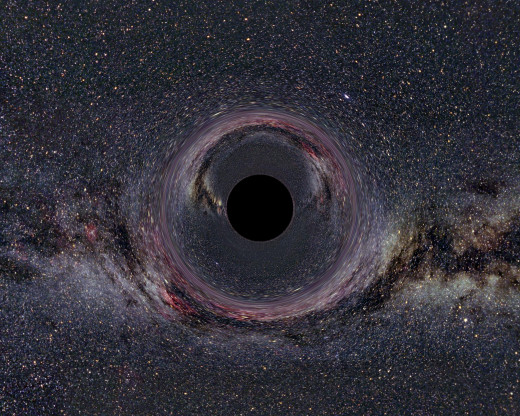
Globular Cluster
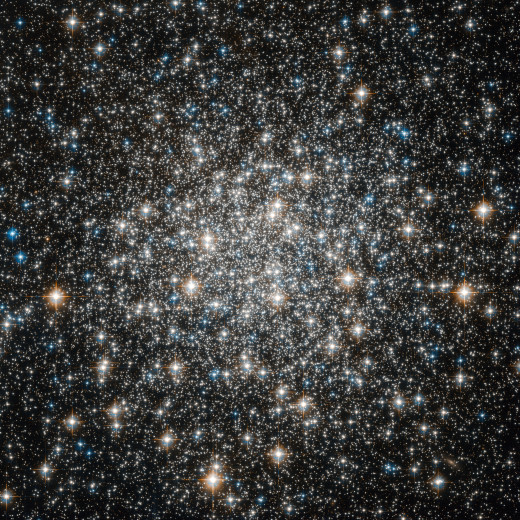
Common Entities
Another small star, in fact the most common type in the Galaxy, is a red dwarf. Proxima Centauri, the closest star to Earth, is one example. They are considered either a K or M-class star. Red dwarfs are cool, dim stars with surface temperatures of 6,500 degrees and radiate at 10% the Sun’s luminosity. Their fuel burns very slow, perhaps with the ability to do so for trillions of years. Red dwarfs are less than half the mass of the Sun.
Black holes form along the same process as neutron stars, except their leftover mass after supernova must be greater than 3.2 times that of the Sun. Such overwhelming gravity forms a point of infinite density, known as a singularity. Before exhausting fuel supplies, these objects are 20 times the mass of the Sun. (Black holes are covered in greater depth throughout Chapter 4.)
Supernovae are the climactic fate of stars with solar masses greater than 1.5. They are nothing more than an exploding star. Neutron stars and pulsars are remnants of such events. A supernova will appear as one of the brightest objects in the night sky should the light from one ever reach our perspective. Heavy elements formed from supernovae during the formation of the Galaxy, which is one reason life had the ability to originate. The Solar System contains many other remnants from these early explosions. One such element is carbon, the basic building block of life, which forms from helium in an exploding supernova. Without supernovae, life never would have appeared in the Universe. Life is basically the leftovers of stardust.
Globular clusters contain some of the oldest stars in the Milky Way. They are nothing more than large groups of stars in close proximity. Messier-4 is one of the closest of these groups to Earth at about 6,500 light years away. There are over a hundred of these clusters in our Galaxy, alone.
Quasars are some of the brightest, oldest, largest, and most powerful objects in the Universe. They emit a bright blue color, indicating extreme high temperatures, and are observable toward the far reaches of space and centers of some galaxies. Some quasars are the transitory stage of a new galaxy believed to be driven by the power of a supermassive black hole or the accretion disc around one. They are similar to protogalaxies, or objects in the early stages of galaxy formation. Energy emitted from a single quasar is 1,000 times that emitted from the entire Milky Way. At the core of a quasar, astronomers and astrophysicists believe, lurks a supermassive black hole.
A brown dwarf is nothing more than a failed, low-mass star. Low-mass stars are between 80 and 200 Jupiter masses. Brown dwarfs are lower yet, anywhere between 15 and 70 Jupiter-masses but all roughly the size of Jupiter. Most planets catalogued outside the Solar System average 10 Jupiter masses. If the luminosity of the Sun equals one solar luminescence, other low-mass stars are a small fraction of that. These stars fall between 10(-4) and 10(-2) solar luminescence. Brown dwarfs are dimmer yet, anywhere between 10(-7) and 10(-4) SL. Planets, which give off a very low amount of light, are 10(-7) SL or less. Brown dwarfs are objects between what should be defined as either a star or planet. They are too dim to be stars and too big to be planets. Evidence suggests these objects are as common as any other star, if not more so, but scientists are unable to identify them consistently since they can resemble one.
Nebulae are isolated clouds of gas and dust that, over time, coalesce to form stars. Some of them are remnants of supernovae explosions, called supernovae remnants. Nebulae are the most visually spectacular objects in the Universe.
Crab Nebula
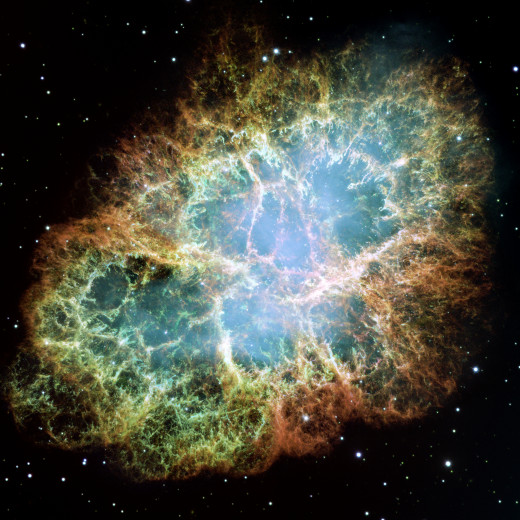
Artist's Rendition of an Extrasolar Planet
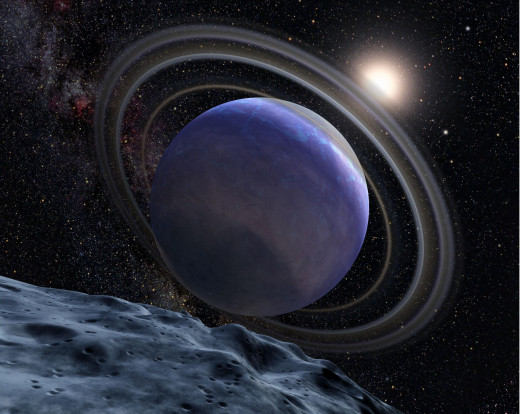
Extrasolar Planets
The first confirmed discovery of an extrasolar planet was in 1992. By January 2000, astronomers verified a total of 29 different planets orbiting Sun-like stars. In October 2000, that number increased to 44, three of which orbit a single star—the first evidence of another solar system. As of January 2014, there are a total of 1,070 verified extrasolar planets in over 810 solar systems. Ten of those planets are located in the habitable zone of their system like Earth is in ours. Additional evidence suggests there may be 30 habitable extrasolar moons in proximity.
Astronomers discover new planets at a rate of one every three days, a number that will increase as better detection methods become available. The farthest planet discovered is 17,000 light years away, toward the center of the Galaxy.
Planet finders Geoff Marcy and Paul Butler are able to detect a star’s wobble up to 170 light years away. Radial velocity is the method astronomers use to detect extrasolar planets. When Marcy started searching for them, astronomers would look down at their feet in embarrassment. Perhaps he now does the same in return.
In 2009, NASA launched Planet Finder, a three-hundred-foot interferometer placed in a high solar orbit. The hope is it will allow astronomers to detect and verify other Earth-like planets. If one exhibits Earth-like properties, it will show up as a pale blue dot. Interferometers of the future might enable astronomers to see clouds, continents, even oceans. For the most part, they detect Jupiter-like planets by measuring their star’s wobble, or gravitational tug from the planet. All planets produce minute, yet detectable pulls on their star.
Deductive logic insists the Galaxy must be teeming with planets. There is a ratio of five to four rocky planets to gas giants orbiting the Sun. Since our Solar System is no more special than any other, a typical system should harbor a similar ratio. The Galaxy should be teeming with both gas giants and rocky planets. Logical deduction has provided inaccurate results before, but so too have many scientific hypotheses. Nevertheless, it is reasonable to assume astronomers will discover similar solar systems to our own. It is only a matter of time.
WMAP Cosmic Background Radiation
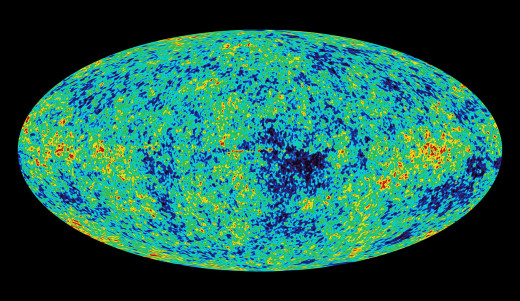
The Space-Time Continuum
“So I conjectured that our universe had its physical origin as a quantum fluctuation for some preexisting state of nothingness”—Edward P. Tyron[i]
Astronomers once thought the Milky Way was the whole of the Universe, and beyond it lay nothing but the blackness of space. They thought it was stationary and unchanging. Edwin Hubble changed all that in 1917. He discovered the Universe was a container of many galaxies expanding in all directions. Hubble applied the Doppler effect to the different pitches of light emanating from distant stars and found they were not stationary, but moving apart from each other. As the evidence mounted, physicists like Albert Einstein and other astronomers of the time had no choice but to concede. Hubble discovered distant galaxies, once thought to be cloudy nebulae, which provided additional proof of this rapid expansion. Most scientists abandoned the idea of a static Universe, once and for all.
Astrophysicist and theorist David Spergel believes if the Universe is finite, a person could travel in a “straight line” through space and find himself back at the original starting point. He and astrophysicist Glenn Starkman believe it is possible the image astronomers have of space containing billions of galaxies may be an illusion. The Universe could resemble a giant hall of mirrors. Distant galaxies, as seen through the Hubble Space Telescope, may include images of younger versions of the Milky Way as it continues its expansion in a finite Universe. The cosmos may not hold as many galaxies as astronomers once thought. Multiple images of them may result from the light of a far smaller number following different pathways at different coordinates during their expansion. The Universe could be so large as to make it impossible to see those reflections from our vantage point.
Physicist Kip S. Thorne argues the question of whether the overall structure of the Universe is flat or curved is a matter of philosophy, not physics. He believes either structure is inconsequential since the measurements one acquires with clocks or rulers will display similar results. Whether either structure produces similar results today, the question of space-time being flat or curved might have important implications for applications of future technologies, such as intergalactic space travel and warping of the space-time continuum.
Dimensions are functional characteristics of how mathematicians structure the Universe. Zero dimensions are invisible points in space from which all others originate. They are the basis of all other dimensions and the blueprint of reality. A single dimension is similar to a line. It has no physical characteristics, only calculable determinates. Zero and one dimensions are coordinates with no visible properties. A sheet of paper is a good representation of a two-dimensional structure. It has a dimension of length plus one of width, but no depth. All visible structures in the Universe are three-dimensional, which includes length, width, and depth. Time is referred to as the fourth dimension, its existence more dependent on calculations than dimensions of zero, one, and two. Mathematically, it is the coordinate of a random, three-dimensional event as it occurs in random motion. Scientists call this the arrow of time.
[i] Tryon, Edward P., “What Made the World.” New Scientist Magazine. (March 8, 1984): p. 15.
Figure 2
Big Bang Expansion
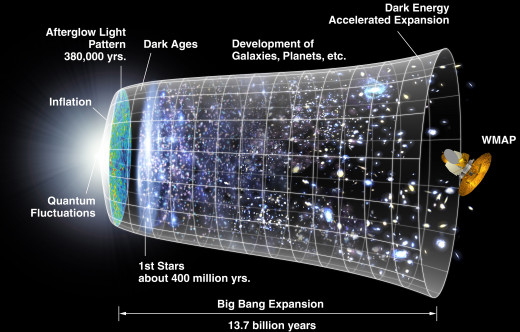
The Big Bang
(*Please click on matching diagram link above for a visual.)
“We are an impossibility in an impossible universe”—Ray Bradbury[i]
The big bang was the beginning moment of space, time, and physical reality, which, in itself, is the entire Universe. Cosmologists designate it as the onset of existence, whereby nothing existed before its primordial event, not even measurable time. (Other theories for how the Universe came into existence are mentioned in Chapter 4.)
The big bang does not explain how the Universe began, as often misinterpreted, rather how it evolves. Scientists define its cosmology as “theories that operate with a temporally finite Universe that has evolved from either a superdense state or a singularity in space-time…a violent beginning or ‘creation’ of the Universe, a first event before which there existed neither time nor space.”[ii]
Some people refer to a beginning model of the Universe as creation, implying it must succeed a creator. Proponents of this interpretation call the study creationism. In order to avoid impartiality, this book will suppress any fundamental religious model. Not only are some religious interpretations contradictory, they themselves do not avoid impartiality. A small amount of scientists do adhere to a form of creationism but an interpretation of it that incorporates the big bang and scientific model. True creationists dismiss the scientific method altogether.
In the spring of 1992, the Cosmic Background Explorer vindicated the big bang, dismissing rival steady-state theory and plasma cosmology. COBE was a satellite launched by NASA to determine the relevance of either theory. The FIRAS instrument on COBE measured the background radiation of the Universe and found they matched predictions of the big bang theory to a high degree. The ripples in the background radiation should have laid to rest all other opponent theories to the big bang, but others persist.
In 2001, WMAP, the Wilkinson Microwave Anisotropy Probe, was launched and gave us a better view of this cosmic background radiation, or oldest light in the Universe. It determined, within one percent accuracy, the age of the Universe at 13.7 billion years old. Current estimates put it at 13.8 billion. The only thing it did not explain was the overwhelming amount of missing matter. (Details for this mysterious matter are forthcoming in Chapter 3.)
Belgian priest and astronomer Georges-Henri Lemaitre was the first to outline big bang theory with the hypothesis of the primordial atom. From that first atom, which was the original state of the entire Universe, all matter came into existence. The atom did not appear or expand within the Universe, rather did so as the Universe. The Universe originated from itself, as itself, not from some mysterious, outside realm; for, according to the big bang model, nothing existed a priori.
In December 1979, Alan Guth proposed the idea of inflation theory, that the Universe experienced a sudden increase in expansion during the initial one hundredth of a second following the big bang. After 10(-35) seconds, the Universe grew at an exponential rate before settling into a more sedate expansion period outlined in the original big bang theory.
Big bang cosmology, according to the standard model, asserts the Universe had a temporary, finite beginning that developed from a superdense state, called a singularity. It began as a region a billion times smaller than the size of a proton particle, incorporating the primary reality of physical existence, space, and time. Out of this “explosion” of primordial, physical matter less than a trillionth of an inch in diameter is the sum density of all existing matter, including space and time. The density of such a state is next to infinite.
Within a billionth of a second, the Universe expanded from the size of a proton to the size of Earth. Scientists call such rapid expansion inflation. Many physicists argue this inflation is a result of a spontaneous materialization of particles out of a complete vacuum of nothingness. They believe these particles flicker in and out of existence to disappear again into oblivion, all within a fraction of a second.
The original gravitational field provided the required energy to expand the entire Universe. The appearance of matter created this gravitational field in the first place. But if the total energy of the Universe is zero, and that is the consensus among cosmologists, how did it obtain something from nothing? How did the Universe acquire its free lunch? The answer is that all the antimatter that once existed, after continuous annihilation with matter particles outnumbering them, disappeared from the Universe, leaving behind an abundance of matter. This matter-antimatter asymmetry permits existence yet keeps the overall energy of the Universe at zero.
Scientists can only determine what occurred from one microsecond after the big bang to the present. What happened before this point is entirely speculative. For this reason, they shy away from addressing such fringe topics. Only do quantum theorists and philosophers dare to venture beyond this unverifiable realm.
Why do many cosmologists fail to acknowledge potential properties of a hyperspace container of universes out of which our Universe began as a unique quantum fluctuation? The main reason is because they do not believe negative energy exists.
The Hartle-Hawking Theory of the big bang, proposed by James Hartle and Stephen Hawking in 1983, details why time does not extend back to infinity before the big bang.[iii] To put it in simple terms, the Universe has no boundaries. It is contained within itself as is time within the Universe. The theory provides no causal explanation for why the Universe exists but provides unconditional probability for its existence. It exists without the need for reason or explanation. It just is.
Endorsed by Ernest Sternglass in 1978, the electron-pair model of the big bang, unlike the standard model, allows for the existence of 10 or 11 dimensions outlined in string theory. The standard model does not dismiss the notion of other dimensions but has a difficult time explaining it. According to the electron-pair theory of matter, the Universe began as an electron-positron pair that contained the entire mass of itself. This primordial atom, about a trillionth of an inch in diameter, appeared out of nothingness. The electromagnetic field of this atom was the original boundary of physical space.
Electron-pair theory dismisses the notion of an infinitely dense singularity at the big bang described by classical general relativity, but permits a natural explanation for the origin of the Universe. While it does appear “naturally” convincing, Einstein has shown what is natural defies many commonsense notions of the Universe. Therefore, the possibilities of singularities, big bangs, and quantum hyperspace must remain open whether they appear natural, logical, or illogical.
According to recent scientific data, the first 10,000 years of the Universe consisted of nothing but a dense sea of radiation. At around 300,000 years following the big bang, it became transparent, and matter began to disperse and go in separate directions. Galaxies began forming 500 million years later.
On a fourteen-billion-year timescale, the following list is a brief summary of cosmic evolution from the big bang to the present:
1) Formation of nucleons from a quark soup at about 10 microseconds.
2) Big freeze-out after one second.
3) Formation of helium nuclei in the first three minutes.
4) Electrons surround nuclei to make atoms at about 500,000 years, creating a transparent Universe and producing cosmic background radiation.
5) Star and galaxy formation begin after one billion years.
6) Production of heavier elements, such as carbon, oxygen, and others needed for life, at about two billion years, a result of nuclear fusion in stars.
7) Supernova explosions spewing heavy elements into space at six billion years.
8) Formation of new stars and planets at nine billion years.
9) Birth of the Sun after 10 billion years.
Evolution of life and intelligence on Earth at 10 to 11 billion years to present day.
[i] Bradbury, Ray. Bradbury Speaks: Too Soon from the Cave, Too Far from the Stars. New York: HarperCollins, 2005, p. 44.
[ii] Encyclopedia of Cosmology, 1993. “Big Bang Cosmology,” p. 31.
[iii] Hartle, James; Hawking, Stephen, “Wave Function of the Universe.” American Physical Society: Physical Review. D 28 No. 12, (15 December 1983): pp. 2960-2973.
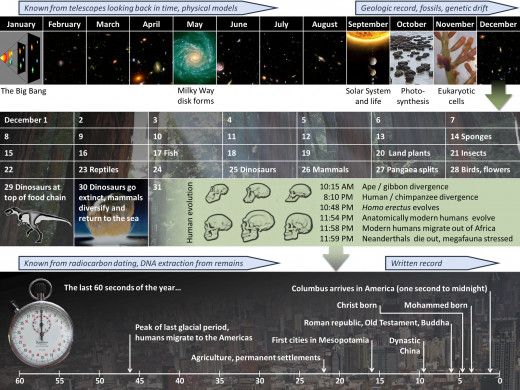
The Cosmic Calendar
We are the product of 4.5 billion years of fortuitous, slow, biological evolution. There is no reason to think that the evolutionary process has stopped. Man is a transitional animal. He is not the climax of creation. In the cosmic perspective, there is no reason to think that we are the first or the last or the best.—Carl Sagan[i]
The vast distances between star systems and galaxies are not the only concepts difficult to grasp. Comprehension of the entire history of the cosmos is an endeavor in itself. Because of this, cosmologists devised a comprehensive analogy of the history of the Universe, called the Cosmic Calendar. Carl Sagan popularized this small-scale rendition during the 1980’s on his Public Television series, Cosmos. Many cosmologists offer various interpretations of their own, precise calculations varying somewhat.
The following list includes a few key dates found on the calendar and is a summarized version from Carl Sagan’s The Dragons of Eden.[ii] Scale is one calendar year:
1) January 1: Moment of the big bang or beginning of the Universe.
2) January 24: Formation of the Milky Way.
3) September 9: Formation of the Solar System.
4) September 14: Earth solidification.
5) September 30: Appearance of first life on Earth.
6) December 1: Appearance of oxygen atmosphere.
7) Dec. 19: First insects and land plants.
8) Dec. 23: First reptiles and trees.
9) Dec. 25: First dinosaurs.
10) Dec. 30, 10:00 a.m.: Comet impact that killed off the dinosaurs.
11) Dec. 30: First primates.
12) Dec. 31, 11:40 p.m.: Homo erectus.
13) Dec. 31, 11:57 p.m.: Neanderthal.
14) Dec. 31, 11:58:38 p.m.: Cro-Magnon.
15) Dec. 31, 11:58:57 p.m.: Homo sapiens.
16) Dec. 31, 11:59:30 p.m.: First human history.
17) Dec. 31, 11:59:55 p.m.: Ancient Greeks.
On the cosmic timescale, human existence is no more than a blink of an eye just beginning to realize its minute place in such a vast arena. Humility, by the way, is the first step in understanding any reason for existence.
Imagine a civilization 500 years more advanced than we are now. How many aspects of day-to-day life would change for everyone in an instant if they shared their technology with us tomorrow? Could we begin to imagine what that might entail?
Now try to imagine one a million years ahead of us. No matter how hard we try or how many theories we compose, there is no possible way anyone on the planet could imagine what technology will have in store a million years from now.
[i] Sagan, Carl. The Cosmic Connection. CambridgeMA: Cambridge University Press, 1980, p.5.
[ii] Sagan, Carl. The Dragons of Eden. New York: Ballantine Books, 1986, pp. 10-11.
Feedback
Was This Article Helpful?
GLOSSARY
A Priori Latin for “from what comes before.” Knowledge derived independent of any observation, or information not based on empirical evidence.
Accretion Disc A disc of energy drawn in gravitationally by any astronomical structure, such as a newly forming star, neutron star, quasar, or black hole, in the form of electromagnetic radiation.
Antimatter Matter consisting of an opposite set of quantum properties to normal, everyday matter. An antiproton as opposed to a proton. For every particle of matter, there is an equal and opposite particle of antimatter. The Universe could have been a perfectly normal antimatter realm, but matter won out in this tug of war match. Should matter and antimatter interact with each other, the energy generated would be astronomical. It would require more energy than we can conceivably produce to create antimatter.
Arrow of Time The flow of time in a continuous direction from the past to the present and on to the future. It is Albert Einstein’s view of how time operates and is measured. It also helps support his theory of relativity. While it is a necessary mathematical measurement and is relative to individual observers, a few scientists believe time is an illusion created by human beings, a method of chronologically measuring events in random motion.
Astronomy A natural science that deals with the structure and composition of any celestial object. Any structure found outside of Earth’s atmosphere is astronomy’s realm.
Big Bang The birth of the Universe from a superdense fireball about 13.8 billion years ago. It was not an explosion as much as it was an instantaneous expansion of the Universe, in and of itself. Most physicists believe it was the beginning of space and time and that nothing prior existed.
Black Hole A point in space of infinite gravity where nothing can escape, not even light. A black hole can be observed via its event horizon, or outer perimeter. Some physicists and cosmologists theorize that black holes are gateways to other parts of the Universe or gateways to other universes altogether. The laws of particle physics start to break down at the singularity of a black hole. Nothingness could be at the heart of it or it may sprout into a distinct parallel universe, separate from our own.
Brown Dwarf Basically a failed star. It exhibits both planetary and solar attributes, though is neither. A brown dwarf is something in-between that has the characteristics of both, but can be classified as either.
Cosmic Background Radiation or Cosmic Microwave Background Thermal radiation that uniformly fills the observable Universe. The WMAP satellite provided the best map of this radiation. It highlights only the 4.6% of observable matter in the Universe, implying there must also be dark matter and dark energy to account for the rest.
Cosmology Study of the entire Universe and existence from the very small to the very large.
Creationism The biblical account of Universal origin in which it was created by God. It is in direct contrast to the theory of evolution. Most adherents to creationism believe God created the Universe in a mere 6,500 years, based on literal interpretations of the Bible. All celestial objects in the Universe and all beings on Earth were created perfectly and evolution had no part to play.
Doppler Effect A measured increase or decrease in sound or light waves as they approach or recede from a particular perspective. The sound of a siren increasing in pitch and frequency as it approaches, or decreasing as it recedes, can be measured using the Doppler effect. Distances between stars are also measured this way to determine how far away they are from each other.
Electron Pair Model Theory of the origin of the Universe, put forth by Ernest Sternglass (based on Georges Lemaitre’s “primeval atom” theory), in that the Universe began with an electron and positron pair that was extremely heavy and contained all the original matter in the Universe, all originally the size of an atom! It is different than big bang theory since there is no model for the Universe ending in a big crunch or continuing to expand until it runs out of energy. Originally, all matter in the Universe began in a primordial atom with an electromagnetic field that defines all of physical space.
Extrasolar A planet or any object located outside of our own Solar System.
Free Lunch Physicist Alan Guth’s description of the Universe coming into existence from basically nothing. In inflation theory, it is the origin of the rapid, exponential expansion of the Universe from a true vacuum of “nothingness.”
Globular Cluster A large group of older stars found in the outer reaches of the Galaxy which are in close proximity to one another.
Goldilocks Zone Location of a planet within any given solar system that is “just right” for life to originate and flourish. A star can also be located in the Goldilocks zone of its galaxy considering how inhospitable it is toward the center. Earth is in the Goldilocks zone of the Solar System and our Solar System is in the Goldilocks zone of the Milky Way.
Gravity The weakest of the four fundamental forces of nature, which include the strong nuclear force, the weak nuclear force, and the electromagnetic force. Gravity only appears strong because of our interaction with it, but a single magnet can easily lift a small object off the ground.
Hartle-Hawking Theory James Hartle and Stephen Hawking’s theory that the Universe is infinitely finite and the phrase “before the big bang” has no meaning, specifically because there was no time to measure. Directly following the big bang, there was only space and no time. Time developed as expansion grew and would have transpired faster in the early Universe. In other words, the passage of time we experience now, after 13.8 billion years, ran much faster in the early Universe.
Inflation Theory An extension of the big bang model in that the Universe experienced an extremely rapid expansion during the first few seconds of its birth. WMAP eventually confirmed inflation theory based on cosmic background radiation evidence following its launch in 2001. It revealed that the Universe is basically flat and its slight curvature will slowly increase over time.
Interferometer A special telescope that utilizes multiple mirrors to combine light waves emanating from a distant star system, which will also help astronomers better analyze extrasolar planets. It can use optical, acoustic, or radio frequencies to make these measurements.
Nebula A large collection of gas and dust leftover from an exploding star, or supernova. They are the large “cloudy” looking objects colorfully illustrated in astronomy books and on television documentaries. Color is purposefully added to enhance definition and make the images visually stimulating.
Negative Energy Also known as exotic matter. This theoretical source of energy is thought to reside in a true vacuum where no positive energy exists. In quantum mechanics, they are inherent fluctuations of energy within a magnetic field. It is an unpredictable force thought to also exist around black holes. Harnessing it would be a momentous task, one that only future generations may develop.
Neutron Star A very small, extremely heavy star. Its radius is only 10 miles in diameter and is incredibly dense, weighing in at millions of tons per cubic inch. A teaspoon of it would weigh more than Mount Everest! They form from a collapsing star that explodes with a leftover mass less than 3.2 times than the Sun.
Protogalaxies Clouds of hydrogen gas in the process of forming new galaxies. They are basically primeval galaxies, possibly quasars.
Pulsar A rapidly spinning magnetized neutron star that emits pulses of radio waves. These pulses appear perfectly regular and intentional. Scientists may discover they are perfect universal timekeepers, relative to all observers. Some people believe they could be a neutron star manipulated by intelligent beings.
Quark Soup A possible phase of quantum chromodynamics that exists as plasma at extremely high temperatures and densities.
Quasar It is suggested that a quasar might be a candidate for a white hole since it expels matter rather than sucking it in. A black hole is just the opposite. These objects appear more frequently toward the far reaches of space and some physicists think they lurk at the centers of galaxies. They are bright blue entities, the brightest objects in the Universe, in the transitory stage of becoming a new galaxy. The Milky Way was once a quasar. A quasar can emit 1,000 times more energy than an entire galaxy.
Red Dwarf A red dwarf is a ‘K’ or ‘M’ class star that is very dim, small, and cool, with a surface temperature around a mere 6,500 degrees F. Its mass is less than half that of the Sun. It is the most common type of star in the Galaxy. The nearest star to the Sun, Proxima Centauri, is an example of a red dwarf.
Scientific Hypothesis An educated guess based on observation and experiment. A hypothesis can be disproved, but cannot always be proven to be true.
Scientific Law Better than a theory, or a theory that cannot be disputed. It is a collection or body of observations that explain things rather than describing them. It is the “why” of a theory.
Scientific Theory Better than a hypothesis. A theory is a hypothesis, or group of them, supported with repeated testing. Only when there is no current evidence to dispute a hypothesis is it instead considered a theory. A theory can still be disproved, but no foreseeable evidence exists to do so.
Singularity A point of infinite density inside a black hole where the laws of physics and quantum mechanics break down. Light cannot escape a singularity and the measured flow of time appears to stop. All that enters the singularity becomes obliterated by the overwhelming, near infinite gravity.
Solar Mass Used as a unit of measurement comparable to our Sun, or 1.989 x 10(30) kg. A star twice as large as the Sun would be two solar masses, and so on.
Standard Model The overall model of particle physics that relate to the four fundamental forces of nature: electromagnetism, the strong force, the weak force, and gravity. Once the model is able to incorporate the graviton and properties of dark matter and dark energy, it will become complete. It is the prevailing theory of particle physics. Recent discovery of the Higgs-boson particle might help complete the picture.
Steady State Theory It is an alternative theory to the big bang. The Universe had no beginning and space is infinite. Though the Universe is expanding, it basically looks the same as it always did. The theory no longer holds any water since an overwhelming amount of evidence points to some beginning, specifically the big bang. However, a handful of scientists that adhere to the many worlds interpretation have recently revived the theory and supported it with mathematical evidence.
Supernova An exploding star that has exhausted its fuel supplies. The heavy elements leftover are the basic building blocks of life throughout the Universe. Without supernovae, we would not be here. Carbon based life forms could not originate without the heavy elements they spew into the cosmos.
White Dwarf A star that swells to the size of a red giant, then gradually shrinks to the size of Earth instead of exploding into a supernova. Its solar mass remains the same; yet its density will be hundreds of tons per cubic inch. The Sun will eventually become a white dwarf.



![How The Universe Works [Blu-ray]](https://m.media-amazon.com/images/I/51T-48hwsML._SL160_.jpg)



